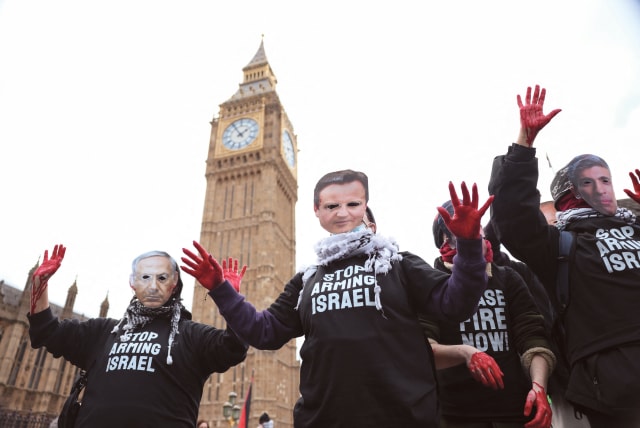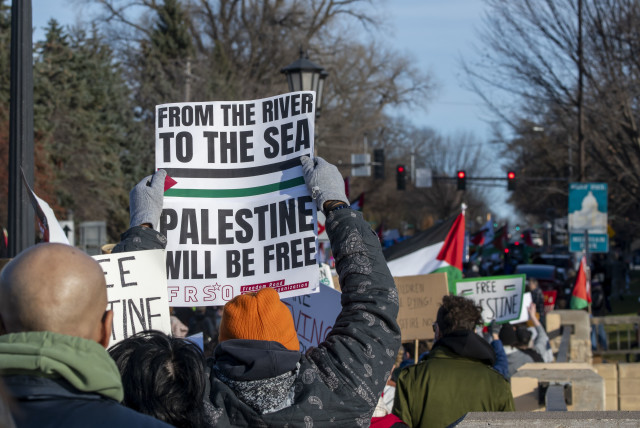The warning signs in symbols and slogans of the pro-Palestine cause - comment

Nothing is lost in translation, but there are still those who prefer not to read the writing on the wall in any language.
The humble watermelon provided me with food for thought lately. Until recently, it symbolized for me a refreshing summer fruit – the sort of treat Israelis naturally serve when guests arrive, invited or by chance. Choosing a watermelon is a skill, and the subject of heated debate in more peaceful times when the general public can afford to be distracted by such arguments. (For what it’s worth, based on experience gained when I picked them years ago, I’m among those who believe the way to select a ripe watermelon is to hear a hollow sound when you tap it.)
But the watermelon has been hijacked by Hamas and its supporters. It is no longer just an innocent fruit. It is a symbol. The role of its colors – red, green, and white, with black seeds – has been revived as a proxy for the Palestinian flag. Triangular slices of watermelon feature on pro-Palestinian apparel and social media posts of the type that leave me with a bad taste in my mouth.
My social media feeds are full of clips of clueless Palestinian supporters struggling to answer the question “Between which river and which sea?” they are referring to in their call: “From the river to the sea, Palestine will be free.” It’s not easy for Israelis like me – living between the Jordan River and the Mediterranean Sea – to hear people calling for our genocide and replacement, even if many of those shouting are idiots mindlessly following today’s cause célèbre.
I often wonder how the same protesters would fare if they were presented with the Palestinian flag and the almost identical flag of the Hashemite Kingdom of Jordan and had to guess which is which – let alone considering the reasons the two flags are so similar and whether, perhaps, the Palestinians already have a state.
'From the river to the sea' slogan
THE SO-CALLED free world has become dangerously used to rowdy, sometimes violent, protests in major cities where the mantra “From the river to the sea” is a recurring theme, but last week, London saw a new display of hatred and it was seen in a way that should not be ignored. During the parliamentary debate on the situation in Gaza, initiated by the opposition Scottish National Party (SNP), the “From the river to the sea” slogan was projected onto the side of the Elizabeth Tower, better known as Big Ben.
The debate – if you could call it that – was a farce. The Speaker of the House, Sir Lindsay Hoyle, flouted normal parliamentary procedure and, as has been pointed out in multiple commentaries since, acted out of fear. Labour MPs feared the consequences, were they not able to vote on their own ceasefire amendment, rather than the SNP motion. Parliamentarians were intimidated and there are reports that some MPs had received threats to their families.
Since the fatal jihadist-inspired car-ramming and stabbing attack outside the Houses of Parliament in 2017 and the assassination of Conservative MP Sir David Amess in October 2021 by ISIS-supporting Ali Harbi Ali, you can’t blame them for taking the threats seriously. It is the way the threats are dealt with – or not – that is the problem.
At the beginning of the month, Justice Minister and Conservative MP Mike Freer, representing Finchley and Golders Green, announced he would be stepping down in the wake of the threats he has received, including an arson attack on his office in January. According to The Guardian, “When asked whether he was being targeted because he represented a constituency with a large Jewish population, Freer said: ‘I can’t draw any other conclusion... The level of abuse I get standing up for my constituents on antisemitism and on Israel has to be a factor.’”
“I am very, very concerned about the security of all members,” the Speaker told the House of Commons last week regarding the debate debacle. “I was very concerned, I am still concerned, and that is why the meetings I have had today were about the security of members, their families, and the people involved.”
Why a Scottish party decided to use its precious time to initiate a debate on a war in the Middle East and call for an immediate ceasefire is also worth considering, but let’s focus on the message that put the spotlight on Big Ben. Or rather, the message that was spotlighted on Big Ben.
The sound-and-light show was beyond irregular. Nobody had applied for the necessary permits for projecting the genocidal message onto the seat of British democracy. But the Metropolitan Police did nothing to stop the display of hatred – just as they haven’t taken action against calls to “Globalize the Intifada” and other expressions of antisemitism and violence heard during demonstrations and mass rallies.
Fear of being accused of Islamophobia obviously overrides the concerns of the Jewish community, rattled by a wave of antisemitism.
When police are too scared to act, parliament is too frightened to rule, and public figures are too intimidated to speak out, democracy doesn’t just squirm. It could be in its death throes.
The choice of Big Ben for the flashy message of hate was not incidental. The Elizabeth Tower of the Houses of Parliament is such an internationally recognized icon that it basically stands for “Britain.” And make no mistake, it was Britain and its values that were under attack as much as Israel.
The battle is far from being restricted to the capital of the United Kingdom and its symbols. In the United States, blood-red paint has been smeared by anti-Israel protesters on the gates of the White House and the Lincoln Memorial, among other hallowed sites. Places with national significance are being turned into venues for often lawless mass rallies around the globe.
From London to Sydney, police have warned Jews that they are not safe near these demonstrations. Keep in mind that these protests are not just anti-Israel, they are pro-Palestinian – an expression of support for Hamas and Islamic Jihad that carried out the monstrous invasion and mega-attack of October 7, with its mass murders, torture, rape, and abductions.
The deliberate targeting of national symbols can be seen behind al-Qaeda’s 9/11 assault on the World Trade Center, Pentagon, and the presumed destination of the White House by the terrorists on a fourth plane. There is a dotted line that leads from 9/11 to October 7. It’s painted in drops of blood. A lot of blood.
At the crux of the current crisis is an inability to read the Middle East’s geophysical and political map. A similar phenomenon occurred in 2014 when then-secretary of state John Kerry seemed obsessed with his efforts to force some kind of peace agreement between Israel and the Palestinians – ultimately creating the environment that led to that summer’s deadly war – while ignoring the growth of ISIS that would take over vast areas of the Mideast, murdering millions – first and foremost Muslims.
THE TOPIC of symbolism and flags has been on my mind recently. During a series of talks on “Iran’s Tentacles,” by independent journalist Ziv Genesove at Jerusalem’s Beit Hoffman, Genesove noted in passing the Houthi flag and slogan.
Unlike the watermelon version of the Palestinian colors, the flag of the Iranian-backed Shi’ite Islamist Houthis leaves no room for doubt. It clearly states its raison d’etre in Arabic calligraphy. The motto on the flag states: “Allah is the greatest, Death to America, Death to Israel, A Curse upon the Jews, Victory to Islam.”
Nothing is lost in translation, but there are still those who prefer not to read the writing on the wall in any language. In a deadly irony, it should be noted that there are nearly no Jews left in the once-thriving Jewish Yemenite community. They were indeed cursed. They are among those Jewish refugees of the Middle East whom most of the world prefers to overlook.
It’s pertinent to keep in mind that Hamas and the Houthis are on the same side – part of the Iran-Russia-China axis of evil. While the Houthis continue to attack shipping in the Red Sea and launch Iranian-provided missiles and drones at their enemies (including Israel and Saudi Arabia), their mission is being voiced by pro-Palestinian protesters in the West: From the River Thames to the US East Coast – and well beyond.
Ripe watermelons might sound hollow, but the threats that accompany their Palestinian symbolism are not.
Jerusalem Post Store
`; document.getElementById("linkPremium").innerHTML = cont; var divWithLink = document.getElementById("premium-link"); if (divWithLink !== null && divWithLink !== 'undefined') { divWithLink.style.border = "solid 1px #cb0f3e"; divWithLink.style.textAlign = "center"; divWithLink.style.marginBottom = "15px"; divWithLink.style.marginTop = "15px"; divWithLink.style.width = "100%"; divWithLink.style.backgroundColor = "#122952"; divWithLink.style.color = "#ffffff"; divWithLink.style.lineHeight = "1.5"; } } (function (v, i) { });

